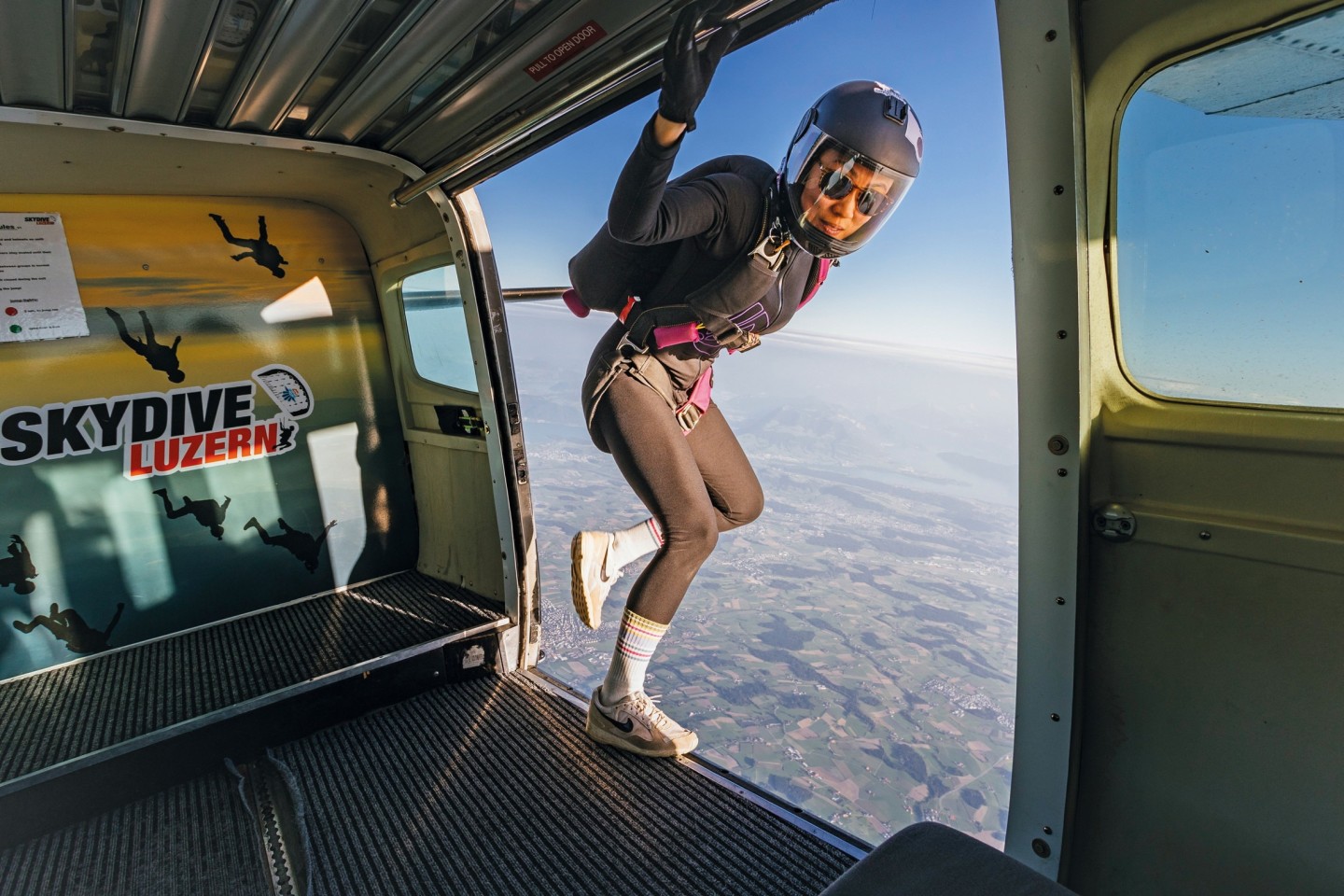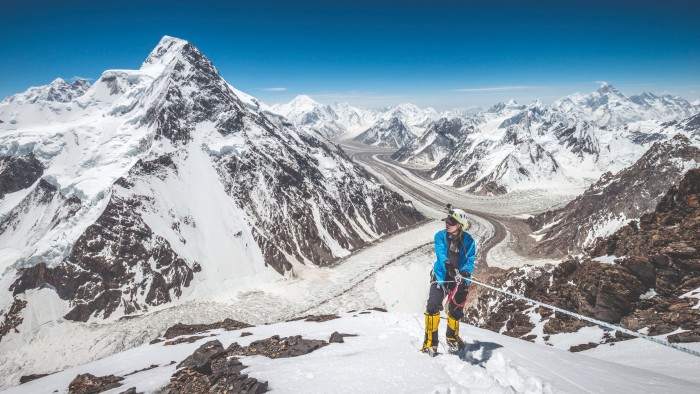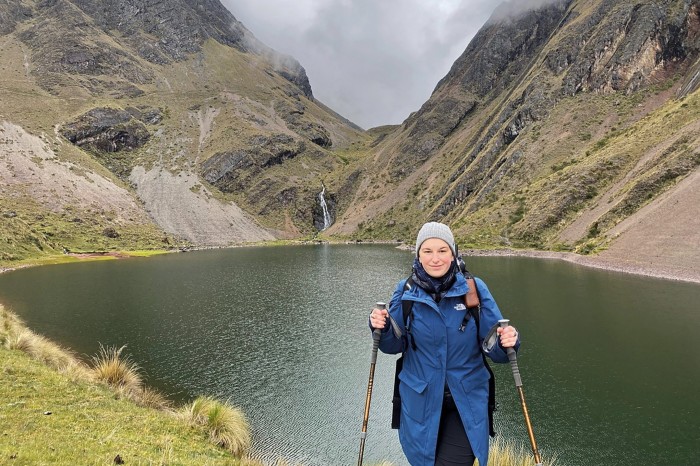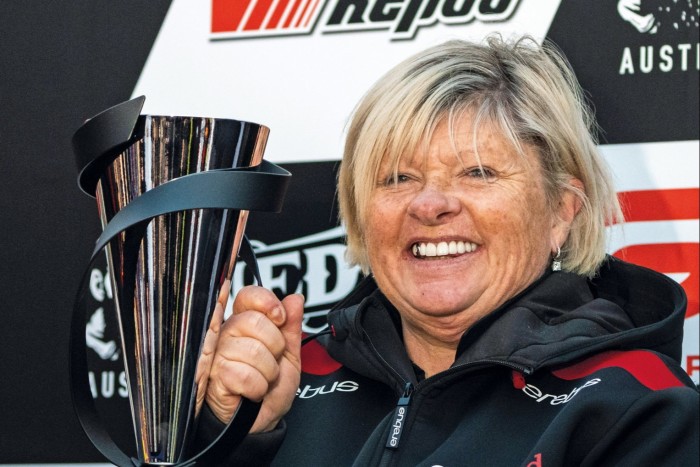High achievers seek high-octane thrills outside the boardroom

Roula Khalaf, Editor of the FT, selects her favourite stories in this weekly newsletter.
Parachute, check. Helmet, check. Safety straps, check. A sudden roar of engine noise. A rush of cold air. Thumbs up. A final deep breath. “Three, two, and . . . jump!”
Four years on from her first solo skydive, Swedish finance professional Alexandra Kraft is hooked. Internal audit manager at education group EF Education First, Kraft now clocks up roughly 100 jumps a year, mostly from a local dive centre close to her home in Zürich. “Skydiving is a high-risk sport, sure, but so is kitesurfing and road cycling,” says Kraft, citing two of her other action-packed hobbies. “It’s just that if it goes wrong, the outcome will most likely be deadly.”
The 39-year-old is one of an apparently growing number of high-net-worth women spending large sums of money to put their lives on the line in the pursuit of adventure — and taking on entrenched gender stereotypes in the process.
Kraft downplays the element of danger in her chosen hobby. She claims to feel no fear, in fact. Not because she is brave, but because she carries out a “very calculated risk assessment”.
For her, the appeal of free falling from 10,000ft centres on the pure joy of the moment. The dopamine rush is also good for her emotional wellbeing, she adds, describing each jump as “like pressing reset”.
Vanessa O’Brien takes a similar view. The 58-year-old former financier took a break from the corporate world after the 2008 financial crisis and never returned. She claims not to seek out risky activities, but nor does she wilt from them when they present themselves. Her modus operandi? “I like to get to say ‘yes’ if I can.”
It’s a policy that has seen her travel to the earth’s highest and deepest points: Mount Everest and the Mariana Trench, respectively. Last year, she was one of two female crew members on a Jeff Bezos-funded rocket launch into suborbital space.

“I see a growing appetite among people to get out of their comfort zone and to grow and develop,” says the British-American O’Brien, who also counts skiing to the North and South Poles among her six world-record achievements.
Personal growth benefits are widely cited in psychological literature as a consequence of high-octane activities. It is also why the likes of O’Brien frequently have profitable sidelines on the corporate speaking circuit.
Yet are there other factors driving female enthusiasm for adrenaline sports? And what are the challenges of breaking into what remains a male-dominated world?
For Grace Lordan, an associate professor of behavioural science at the London School of Economics, the issue of gender is a red herring.
Women might typically have a more measured approach to risk-taking, she says, but, male or female, the buzz of Base-jumping off a cliff, or heliskiing down a glacier is the same for everyone.
The same is true of bragging rights, which Lordan identifies as another motivation for participating in “weird and wacky” activities — something that men and women hope will enhance their social-media streams and mark them out as somehow “unique”.
“As a dinner-party story, saying you climbed a mountain is a whole lot more interesting than saying you went into Louis Vuitton and bought a handbag,” she says.
Tangentially, the rise in female enthusiasm for adrenaline activities could also link to female success in the workplace, she adds.
High-flying women are more likely to have more confidence, making them better equipped for dangerous activities. Having learned to push boundaries at work, it’s “only natural” for them to seek the same in other domains, argues Lordan.
Kenneth Carter, a professor of clinical psychology at Emory University Oxford College in Atlanta, Georgia, concurs. The author of Buzz! Inside the Minds of Thrill-Seekers, Daredevils and Adrenaline Junkies, he points to a “strong correlation” between entrepreneurial business leaders and adventure-seeking.
Part of the reason is a high appetite for risk, he suggests. Just consider how many chief executives hold a pilot’s licence, he notes (answer: “Lots”).
While men might outnumber women in this respect, the two sexes are aligned when it comes to another of Carter’s observations: the propensity of thrill-seekers to have a low boredom threshold.
“Restless” is the word Karina Hollekim, a former professional Base-jumper turned keynote speaker and performance coach, uses to describe her obsession with adrenaline sports. “As a kid, I never found that peace within myself. So, for me, being able to push my boundaries and gain mastery over my fears became the parameter for how well I was doing in myself,” she says.
The tendency to grow bored can set in motion a constant search for the new and exciting. O’Brien calls it “scope creep”. She started out with the sole intention of climbing K2, the world’s second-highest mountain, which, back in 2008, felt like a one-off challenge to “sink [her] teeth into”.
That single summit then became two. O’Brien has since scaled the tallest mountain on every continent. It can be a difficult habit to stop. She imagines scientists mounting an expedition to locate a revolutionary drug deep in the Amazon jungle. “I’d be there in a second,” she insists.
While gender may make little odds in a person’s propensity to boredom, wealth certainly helps in its relief. For a cool $450,000 or so, for instance, you can hitch a ride on a Virgin Galactic flight to space. “I’ve even heard of people paying to get themselves kidnapped,” Carter notes.
Julia Filemyr, an assistant manager at clothing retailer Eileen Fisher, didn’t go quite that far. Still, the 32-year-old New Yorker paid about $20,000 to spend a week getting intentionally lost in the Andean mountains of Peru.
Arranged by the US adventurer holiday provider Black Tomato, the Get Lost concept involves clients paying to be deposited in an isolated spot around the globe and, with the aid of a two-way radio and a basic map, being invited to navigate their way out.
“I read about it in a magazine and I was instantly in love with the idea,” says Filemyr. “I just wanted to do something real and raw that I would otherwise never do.”
Her experience flags two important factors in the “how” of female participation in adrenaline activities. The first is practical; the second cultural.

The practical challenge is that adrenaline sports are not for the faint-hearted, but nor are they for the inexperienced.
Take wingsuit flying. Before giving it a go, would-be flyers are advised to rack up at least 200 skydives. Ideally, you would then undergo extensive training in a specially designed wind tunnel.
This requirement of a basic level of technical expertise and physical fitness is true for many other adrenaline sports, from ice climbing and foil surfing to rally-car racing and mountaineering.
That said, opportunities to gain a taster of the real thing are on the rise. Six years ago, Peter Georén co-founded Inclined Labs in Stockholm, then the world’s first wingsuit flying simulator.
The menu of options starts with a two-flight beginner’s lesson through to a 10-session package for advanced skydivers. “Some only focus on flying here, while others go outdoors as well,” Georén explains. “But the cool thing is that anyone can come off the street and do it with no prior experience.”
As with Filemyr’s Get Lost excursion, holidays often serve as an entry point. London-based Cookson Adventures is one of a growing number of high-end travel operators looking to spice up their luxury trips with a sprinkle of adrenaline.
Managing director Nick Davies prefers the term “soft adventure” to “hardcore adrenaline” to describe the kind of activities on offer, which range from paragliding and canyoning to ziplining and wild camping.
On the flipside, what people do is often less significant to the adventure buzz than where they do it, he argues. His point is that biking through the traffic to work is one thing; e-biking across the Atacama desert is something completely different.
As a source of easy-to-access adventuring, Davies puts particular store by ocean yachting, which he describes as a “fantastic platform to explore” remote places. “That doesn’t necessarily mean the Antarctic or Greenland,” he clarifies. “You can have those adventures off Scotland.”
The second factor at play is cultural. Historically, adrenaline sports have been the preserve of men. While that is changing slowly, some women can still find the testosterone-charged atmosphere of certain intense activities off-putting.
Roz Shaw, a former business owner in the UK automotive sector and now operations manager for Nicholson McLaren Engines, recalls tuts and turned heads when she started out racing historic touring cars more than two decades ago.
“The people running the race series used to look on us as a joke. ‘You should be at home in the kitchen cooking,’ they’d say, ‘not out playing with the boys.’”
Today, such overt chauvinism has toned down. When Betty Klimenko, the billionaire heiress of the Westfield shopping mall empire, entered Australia’s prestigious Supercars Championship as the competition’s first female team owner 10 years ago, there were no female toilets in the paddock. Today, there are.
She hopes that, by stepping out as a high-profile woman, she has opened the door for others who want to come after her. Female race drivers remain a minority, but women are making inroads into motorsport’s other ranks, she says.

Her team’s victory in the prestigious Bathurst 1000 touring car race in 2017 has certainly aided her cause. “You still have an older generation of people on the circuit who think women don’t belong here, but younger people all respect the work women are putting in,” she says.
This residual resentment to female involvement may explain the trend among adventure holidays towards women-only trips. Over the summer, for instance, the bespoke travel company Plan South America organised two all-female heliskiing trips at the behest of clients.
Women seek out adrenaline in exactly the same way as men, observes Harry Hastings, the company’s founder: “If there’s a difference, I guess it’s that they see it less as an achievement to tick off and more as a moment in time to fully experience.”
Back in Zürich, Alexandra Kraft is toying with the idea of wingsuit flying. Her boyfriend is an instructor, but she says she is keen to clock up some on-the-ground training before committing.
“You can put yourself in a wingsuit and jump out of a plane and you will somehow fly,” she says. “But I thought it would be more efficient to do it the right way.”
It’s a decision that reveals little about gender, but an awful lot about the value of common sense.
This article is part of FT Wealth, a section providing in-depth coverage of philanthropy, entrepreneurs, family offices, as well as alternative and impact investment
Comments